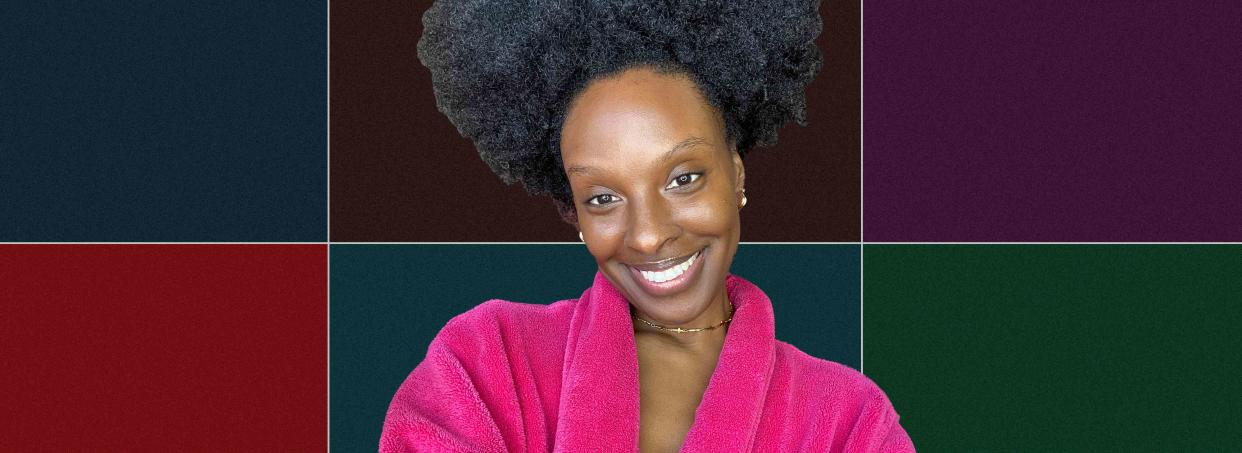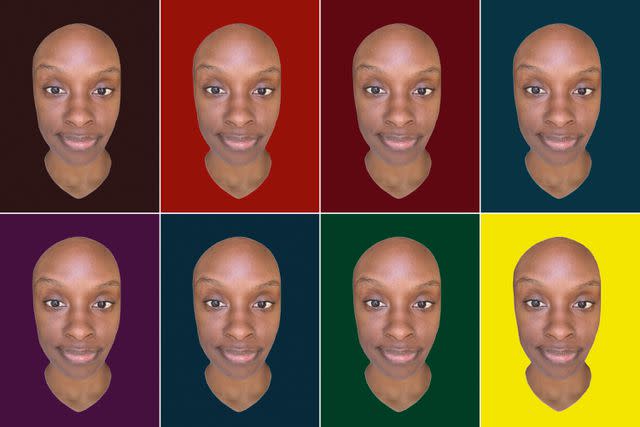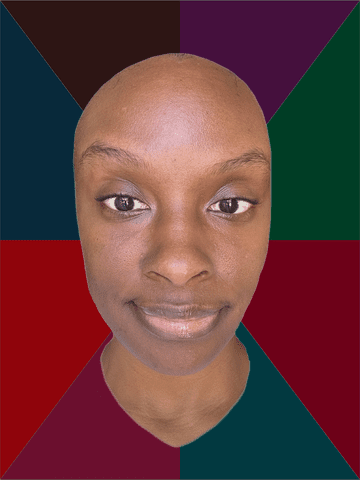I Got a Color Analysis Done to Figure Out My Signature Palette—Here's What I Learned

Essence Gant / Byrdie
If you get more compliments than usual when you wear certain colors, it could be that they're part of your color season—a palette of colors that best complements your skin tone and features. Although she didn't invent it, professional color consultant and author Carole Jackson can be credited for popularizing color seasons, also referred to as color analysis, in the '80s with her self-help book, Color Me Beautiful.
The phenomenon had women everywhere rebuilding their wardrobes to match their season, and like vintage denim cuts and "ugly" sneakers, it has made quite the comeback. TikTokers, many of whom weren't even born in the era, have made countless videos on the subject, testing effects like the popular 12 Seasons Filter and going the extra mile to book appointments with certified specialists. I also tried the viral filter. After settling on Bright Winter… and then Dark Winter, going back to Bright Winter, and then second-guessing everything, I quickly understood the need for an expert’s trained eye. To learn more about color seasons, Byrdie spoke with three color analysis consultants: Micah Lumsden of Cocoa Styling; Tatum Schwerin, of Curated and Clothed; and Ari Cho, of Ari/Rang Color Studio.
Meet Our Expert
Micah Lumsden is a personal stylist and fashion designer. She is the founder of Cocoa Styling.
Tatum Schwerin is the founder of Curated and Clothed. She is known as "The Color Analysis Queen" on Instagram and TikTok.
Ari Cho is the founder of Ari/Rang Color Studio.
What Is Color Analysis?
Simply put, color analysis is a process in which an expert examines your skin tone, eyes, and hair color to determine which color palette season best suits you. The number of seasons may vary depending on who you ask, but most professional color consultants have concluded that there are either 12 or 16 with the possibility that some people can be a combination of seasons.
How Color Analysis Has Evolved Over the Years
Schwerin tells Byrdie that in the ’80s, there were only four seasons: Spring, Summer, Autumn, and Winter. Now there are "16, making pallets more precise and inclusive for all the beautiful complexions on the planet." The additional 12 include variations like Bright Winter, True Spring, and Dark Autumn to account for people's varying skin tones and undertones.
While the color analysis space has seen great improvements over the decades, however, Lumsden says there's still work to be done. "Search either 'color season' or 'color analysis,' and almost none of the results will include people of color," the designer and stylist tells us. It's a claim I can corroborate, as I found very few examples on the web that included people of color. The lack of inclusion is why the style expert tailored the color season system for brown skin first. "There was also the idea that people with darker skin didn’t need to get their colors done because they 'looked good in everything,' which isn’t correct," Lumsden writes. Aside from her website, she also shares informative style and image content on YouTube, Pinterest, and Instagram.
Similar to Lumsden, Cho started her studio "to provide a more inclusive experience to a more diverse community," and she says New York City was the best place to do that. "I think in the past, a lot of people thought that only fair-skinned people could get a color analysis done," she tells us. "However, everyone has colors that they look good in."
What Happens At a Color Analysis Appointment?
The information intake varies by consultant, but the constant is an in-depth color-swatching process. Whether virtually or in person, the consultant applies color theory to determine which swatches complement the client. Appointment pricing ranges depending on location and expertise, but you can expect to pay anywhere from $150 to $500. Appointments may also include makeup and hair color recommendations.
At Ari/Rang Color Studio, clients have an educational sit-down to help them understand color seasons before being assigned their palette. Then the consultant drapes 146 different fabric swatches against the client's skin to examine "their undertones (warm, cool, or neutral tone), and also look into their best brightness, saturation, and contrast levels," says Cho. Through the extensive process, clients walk away knowing their best, second-best, and worst palettes.
Lumsden conducts virtual sessions for most clients, but she provides in-person appointments on occasion. Lumsden requests about 20 to 30 photos from her clients in different settings and creates color swatches in Photoshop to get a starting sense of what their season is. That is followed by a virtual call where the client tries on pieces so Lumsden can fine-tune the palette. Once the image consultant has nailed her clients' analysis, she creates an e-book with tailored information all about her client's season.
Schwerin offers both in-person and virtual appointments at Curated & Clothed. Clients complete a detailed questionnaire, submitting multiple photos and answers to questions like "Did you have freckles as a child?" She makes individual assessments of the eyes, natural hair color, and skin tone before creating a palette. Like Cho, Schwerin shows clients their most flattering and least flattering colors, metals, and neutrals. Clients also receive a booklet full of more information about color theory and their analysis.

Essence Gant / Byrdie
The Benefits of an Expert Color Analysis Versus Doing Your Own
Besides the obvious of looking great in your clothes, there are so many benefits of investing in an expert color analysis. Schwerin tells us that it prevents people from wasting time and money on pieces that don't complement them. It also creates a more cohesive wardrobe of pieces that work well together. "You are able to invest in lifelong pieces," she says.
Lumsden echoes the sentiment that it's an investment. While you can do your own color analysis, she says it requires you to be completely objective about your appearance. "There's a science to it. You are not just choosing pretty colors," the specialist tells Byrdie. "For example, two colors may have the same hue of olive green. But what if one is a bit more yellow or if one is a bit more muted? Those tiny things influence how a color looks on you."
Best Practices for a Self-Analysis
Cho says that conducting an at-home test can be tricky because you likely won't have the hundreds of swatches an expert does. "Some people also just have a hard time seeing the difference between warm tones and cool tones, especially if they have a strong preference," she adds. But good natural lighting is a must so you can draw the best conclusion. She also advises trying it with a friend to get a second opinion.
Although they're trendy, Lumsden's first piece of advice is to "ditch the filters" because the smallest details, like the light from your phone screen, can affect the result. She suggests taking pictures in natural lighting and says you can try swatching felt squares. Felt doesn't have a reflective surface, so a non-expert may be able to more easily assess how the color looks on them.
My Virtual Color Analysis Results
Schwerin of Curated & Clothed conducted my virtual color analysis, and I couldn't wait for the results. She concluded that I'm a Dark Winter—"a beautiful mix between the cool winter palette and the warm autumn palette." According to the informative eight-page booklet detailing my results, "the deep palette inherits a richness from autumn while also incorporating the jewel tone effect of winter." Some of the colors that complement people in my season are red wine, dark lemon yellow, dark emerald, vivid teal, and Prussian blue. A bonus of being what the certified image consultant calls "a deep" is that I can "fall back on my home season," meaning I can dabble in some of the winter colors like the pinks, which I love. Light colors, especially light pastels, however, are typically not advised because they wash out my complexion.

Essence Gant
As for neutrals, "You're going to see that neutral tones look absolutely amazing on a deep," Schwerin says in the results video. Browns, blacks, whites, and tans tend to work very well for a Dark Winter. Similarly, when it comes to gold, silver, and rose gold metals, a deep can wear them all. I typically lean into gold jewelry, but it was great to know that can I switch it up when I rock my big silver hoops a few times a year. She also gave me makeup advice, suggesting foundation with a neutral undertone, black mascara, true red lipstick, and various eyeliners from my palette to make my eyes pop.
Included in my results were photos of my face against swatches from every season, a video explainer of my analysis, a digital color wallet, a color name chart, a link to compatible makeup, and an eight-page PDF booklet explaining the Deep Winter palette. Overall, I was very satisfied and impressed at just how extensive the results were.
My Final Thoughts
There are variations of most colors in each palette, which I find rather empowering. It's not that a particular color is a total no, but perhaps the color in a specific shade makes your skin pop more than it does in other shades. Finding your season may be a bit difficult, which is why experts advise investing in a professional analysis. The benefits are plentiful, starting with a boost of confidence in knowing exactly what you look best in, as well as building an intentional wardrobe of pieces you'll actually wear. And yes, technically, you can do your own color analysis, but it can be overwhelming and tricky to get right, so it might be worth it to pay the experts.
Read the original article on Byrdie.

